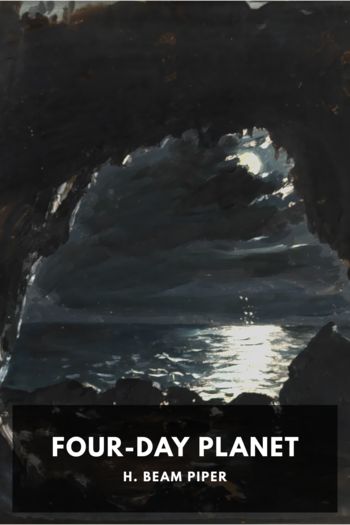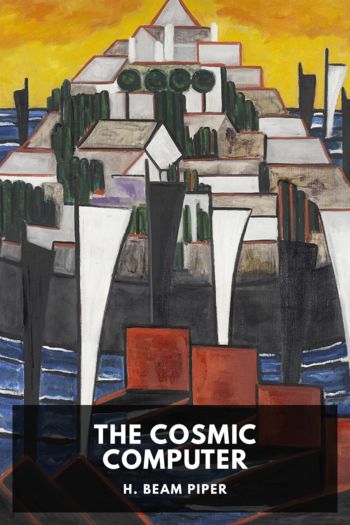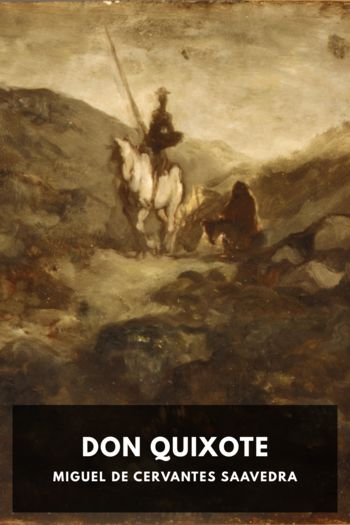Four-Day Planet, H. Beam Piper [best motivational novels .TXT] 📗

- Author: H. Beam Piper
Book online «Four-Day Planet, H. Beam Piper [best motivational novels .TXT] 📗». Author H. Beam Piper
“Twenty-four thousand, seven hundred and eight, if the man who got pounded in a barroom fight around 1330 hasn’t died yet,” I said. “But you have to remember that this place was built close to a hundred years ago, when the population was ten times that much.” I’d gotten my story from him; now it was his turn to interview me. “You know something about the history of Fenris, I suppose?”
“Yes. There are ample sources for it on Terra, up to the collapse of the Fenris Company,” he said. “Too much isn’t known about what’s been happening here since, which is why I decided to do this book.”
“Well, there were several cities built, over on the mainland,” I told him. “They’re all abandoned now. The first one was a conventional city, the buildings all on the surface. After one day-and-night cycle, they found that it was uninhabitable. It was left unfinished. Then they started digging in. The Chartered Fenris Company shipped in huge quantities of mining and earth-moving equipment—that put the company in the red more than anything else—and they began making burrow-cities, like the ones built in the Northern Hemisphere of Terra during the Third and Fourth World Wars, or like the cities on Luna and Mercury Twilight Zone and Titan. There are a lot of valuable mineral deposits over on the mainland; maybe in another century our grandchildren will start working them again.
“But about six years before the Fenris Company went to pieces, they decided to concentrate in one city, here in the archipelago. The sea water stays cooler in the daytime and doesn’t lose heat so rapidly in the nighttime. So they built Port Sandor, here on Oakleaf Island.”
“And for convenience in monster-hunting?”
I shook my head. “No. The Jarvis’s sea-monster wasn’t discovered until after the city was built, and it was years after the company had gone bankrupt before anybody found out about what tallow-wax was good for.”
I started telling him about the native life-forms of Fenris. Because of the surface temperature extremes, the marine life is the most highly developed. The land animals are active during the periods after sunset and after sunrise; when it begins getting colder or hotter, they burrow, or crawl into caves and crevices among the rocks, and go into suspended animation. I found that he’d read up on that, and not too much of his information was incorrect.
He seemed to think, though, that Port Sandor had also been mined out below the surface. I set him right on that.
“You saw what it looked like when you were coming down,” I said. “Just a flat plateau, with a few shaft-head domes here and there, and the landing pit of the spaceport. Well, originally it was a valley, between two low hills. The city was built in the valley, level by level, and then the tops of the hills were dug off and bulldozed down on top of it. We have a lot of film at the public library of the construction of the city, step by step. As far as I know, there are no copies anywhere off-planet.”
He should have gotten excited about that, and wanted to see them. Instead, he was watching the cargo come off—foodstuffs, now—and wanted to know if we had to import everything we needed.
“Oh, no. We’re going in on the Bottom Level, which is mainly storage, but we have hydroponic farms for our vegetables and carniculture plants for meat on the Second and Third Levels. That’s counting down from the Main City Level. We make our own lumber, out of reeds harvested in the swamps after sunrise and converted to pulpwood, and we get some good hardwood from the native trees which only grow in four periods of two hundred hours a year. We only use that for furniture, gunstocks, that sort of thing. And there are a couple of mining camps and smelters on the mainland; they employ about a thousand of our people. But every millisol that’s spent on this planet is gotten from the sale of tallow-wax, at second or third hand if not directly.”
That seemed to interest him more. Maybe his book, if he was really writing one, was going to be an economic study of Fenris. Or maybe his racket, whatever it was, would be based on something connected with our local production. I went on telling him about our hydroponic farms, and the carniculture plant where any kind of animal tissue we wanted was grown—Terran pork and beef and poultry, Freyan zhoumy meat, Zarathustran veldtbeest. … He knew, already, that none of the native life-forms, animal or vegetable, were edible by Terrans.
“You can get all the paté de foie gras you want here,” I said. “We have a chunk of goose liver about fifty feet in diameter growing in one of our vats.”
By this time, we’d gotten across the bottom of the pit, Murell’s luggage and my equipment being towed after us, and had entered the Bottom Level. It was cool and pleasant here, lighted from the ceiling fifty feet overhead, among the great column bases, two hundred feet square and two hundred yards apart, that supported the upper city and the thick roof of rock and earth that insulated it. The area we were entering was stacked with tallow-wax waiting to be loaded onto the Cape Canaveral when she came in; it was vacuum-packed in plastic skins, like big half-ton Bologna sausages, each one painted with the blue and white emblem of the Hunters’ Cooperative. He was quite interested in that, and was figuring, mentally, how much wax there was here and how much it was worth.
“Who does this belong to?” he wanted to know. “The Hunters’ Cooperative?”
Tom had been letting me do the talking up to now, but he answered that question, very emphatically.
“No, it doesn’t. It belongs to the hunters,” he said. “Each ship crew owns the wax they bring in in common, and it’s sold for them





Comments (0)